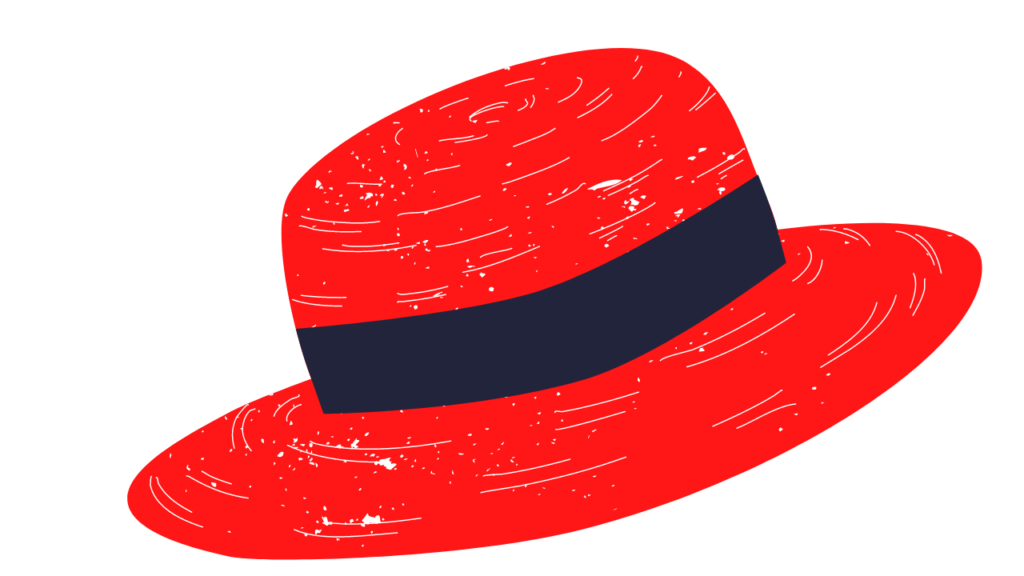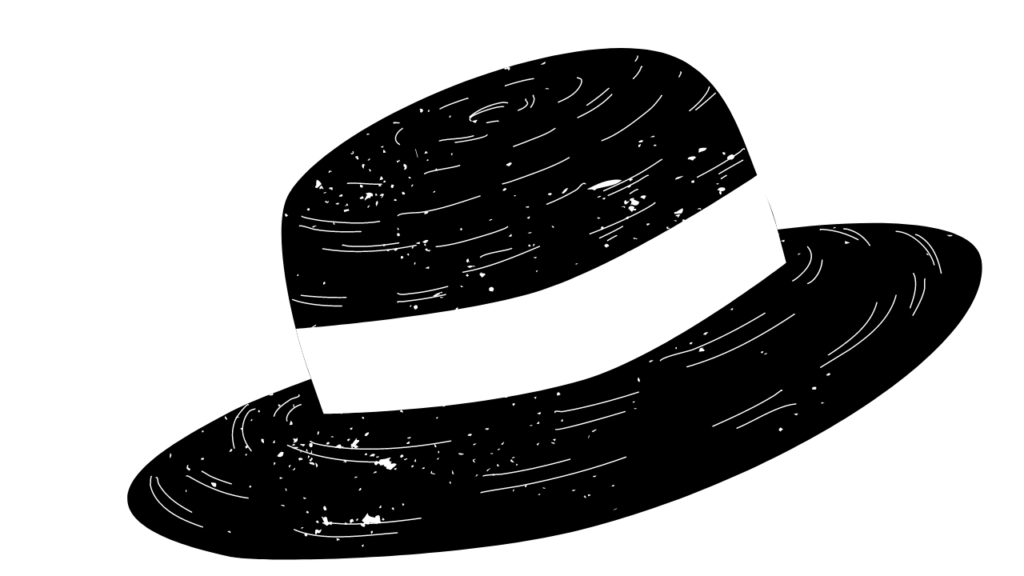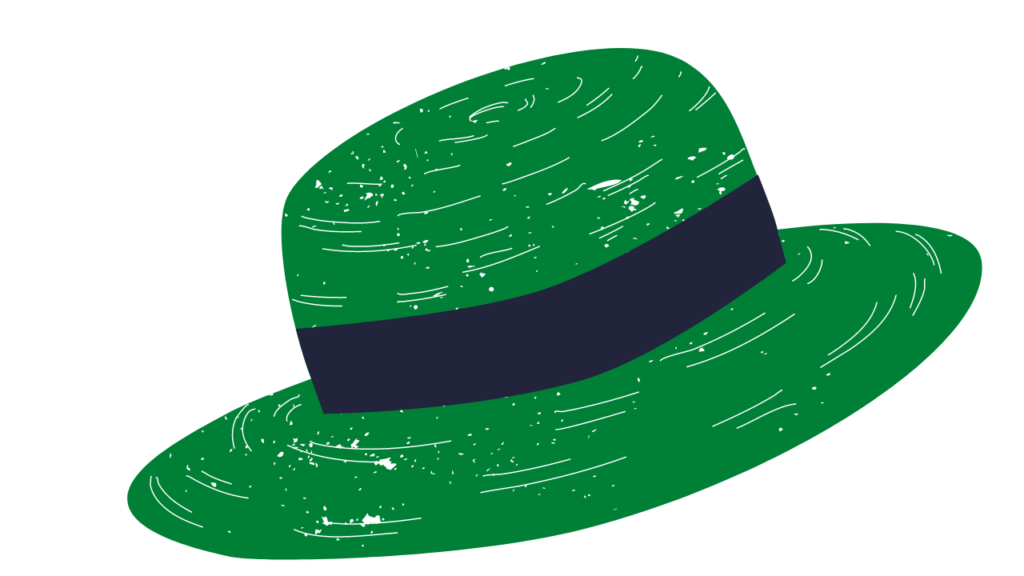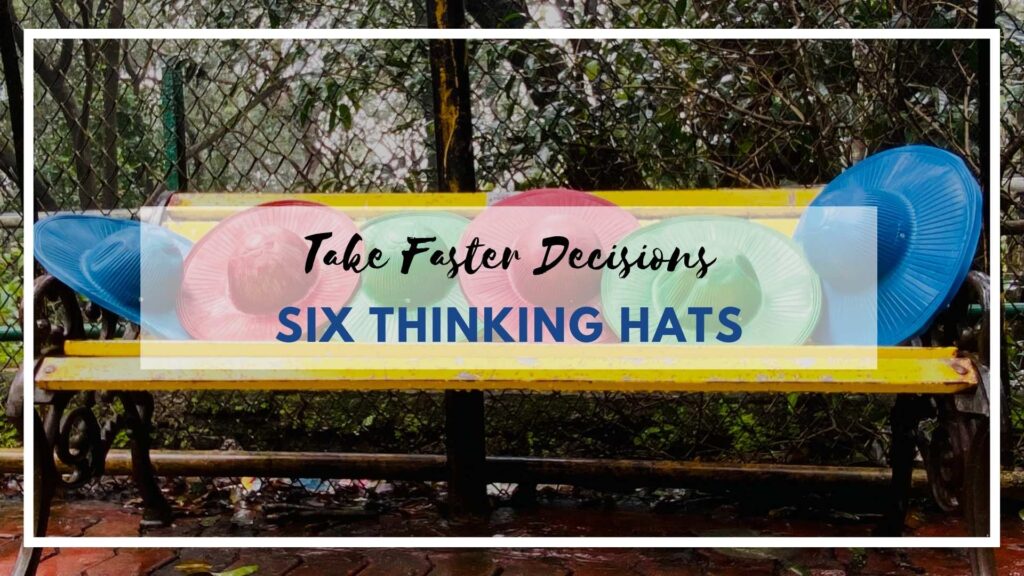Thinking is the ultimate human resource.
Edward de Bono
Hey Everyone, Welcome to another blog in which I intend to share how to run better meeting & take faster decision while working with people. This blog is inspired from a recent read-Six Thinking Hats By Edward de Bono.
The reason I right this is because I found this to be the most best method I have discovered till now when it comes to understanding thinking and effectively using it to your advantage.
The Problem- Juggling with too many balls

The main difficulty of thinking is confusion. We try to do too much at once. Emotions, information, logic, hope, and creativity all crowd in on us. This concept of using the six thinking hats allows a thinker to do one thing at a time.
White of Black? – The Man who Painted his car half white and half black.

Once upon a time, a man painted his car white and the other black. His friends asked him why did he do such a strange thing. He replied: ‘Because it is such fun, whenever I have an accident, to hear the witness in court contradict each other.
And that is what exactly happens in conflicts, meetings and dispute each party focuses on influencing their part of the story rather than collectively thinking and making proper hypothesis of what can be?
The Six thinking helps an individual to move from what is to what can be.
SIX THINKING HATS AND THEIR COLOR
Every color of the six thinking hat is related to its function.
- White Hat: is neutral and objective. The White hat is concerned with objective facts and figures.
- Red Hat: suggests anger, rage and emotions. It aims to give an emotional view.
- Black Hat: is serious. It’s the one cautious and careful. It intends to point out a weakness in an idea.
- Yellow Hat: is sunny and positive. It is optimistic and covers hope and positive thinking.
- Green Hat: It invites creativity and ideas.
- Blue Hat: concerned with control and use of other hats.
Its easy to refer the hat by its color and indicate or make aware someone about their way to thinking without actually pointing it out directly. You can ask someone to remove their red hat for a while rather asking them to stop being emotional. With people who are unaware you could be someone to share or since now you know this direct this among them.
The goal is to sit down at any discussion and switch in and out of ‘hats’ with ease.
Which Hats to choose When?
The first question that arises is how to use them and there isn’t any hard and fast rule. Depending on the situation the type of conversation you are having the sequence of the hats changes.
For Instance Blue hat is above all and it always used in the beginning and the end since it what controls the rest. The Blue hat in the beginning speaks about the agenda, definition, where we want to end up whereas in the end it indicate what we have achieved, outcomes and conclusions.
In situations where there are already strong feelings or opinions on subject it’s recommended to use red hat and get those feelings out right in open at the beginning. In assessment situation , it makes sense to put yellow hat before black.
The White Hat

Think of paper. The White hat is about information.
When the white hat is in use everyone focuses on directly and exclusively on information.
What information do we have?
What information do we need?
What information is missing?
Reporting on your feelings, opinions is not a part of white hat but showing a happiness index of employee in your organization or country is a white hat thing.
Incase if two pieces of information are contradictory we don’t argue straight away we put both of them down in parallel.
The Aim is to be NEUTRAL
The Trap
If you have an enemy provide them with information.
Requesting facts and figures can let to so much of information that you or the people might get overwhelmed and hence request focused information. The goal is to discover and not distort.
Check whether the fact provided is a believed fact or a checked fact. Belief level of fact simple means something which you believe to be a fact but have not yet checked out thoroughly.
Clay Sculpture v/s Drawing a Map
We cannot change cultures but we can develop mechanism that helps to fit a particular culture and eventually drive a change.
In Western-Style it the output is one arrived by everyone and agreeable to everyone. It’s more like a ‘clay sculpture’. There is a core around which pieces of clay are placed and moulded to give final output.
Whereas, The Japanese sit down with out any preferred ideas. The purpose of meeting is to LISTEN. Each participant puts his/her white hat and proceeds to give his piece of neutral information. Its more of drawing a map. With each input the maps gets more complete. The map gets richer and more detailed.
The Information slowly organizes into ideas.
White hat thinking is a discipline and a direction. The thinker strives to be be more neutral and more objective in the presentation of information.
The Red Hat

Red thinking is all about emotions and feelings and the non-rational aspect of thinking. It is almost opposite of white hat thinking.
Once emotions have been made visible by means of the red had, then an attempt may be made to explore and even change them. Thinking can change emotion but it is not logical part of thinking that changes emotions but perceptual.
Intuition is also a part of red hat thinking. It can be classified into two types:
- A sense of sudden insight. It means something which was perceived in one way is suddenly perceived in another.
- Second could be an immediate apprehension or understanding of situation. It is the result of a complex judgement based on experience.
When a thinker is using red hat, there should never be any attempt to justify feelings or provide a logical basis for them.
The Black Hat – Cautious Cap

Black hat thinking is concerned with caution. At some stage we need to consider risks, dangers and obstacles, potential problem and downside of suggestion. The black hat seeks to avoid dangers and difficulties.
Under black hat we focus directly on the cautious aspect. This is the basis of survival, of success and of civilization. The black hat seeks to layout the risks and potential problems in the future. What may go wrong if we implement this suggestion?
The purpose is to put caution points on the map.
Black hat thinking can be abused in no way diminishes the value of the black hat, just as the dangerous and reckless driving of a car does not mean that cars are dangerous.
Yellow Hat

Think of optimism
Under this hat the thinker deliberately sets to find out whatever benefit there may be in a suggestion. We need to develop ‘value sensitivity’. That means being as sensitive value as we already are sensitive to danger
Even the most unattractive idea can have a high value.
Yellow hat thinking is constructive and generative. From yellow hat thinking come concrete proposals and suggestions. It can be speculative and opportunity seeking.
Green Hat

The green hat is for creative thinking. The person who puts on green hat is going to use creative thinking. Search for alternatives is a fundamental part of green hat thinking. There is a need to go beyond obvious and the satisfactory.
Green Hat symbolizes GROWTH.
In this the seeker seeks to move forward from an idea in order to reach a new idea.
It is used to generate new concepts and perceptions.
Blue Hat – Above All

Think of the blue sky above. The blue hat is thinking about thinking.
Conductor of the Orchestra

The blue hat is like the conductor of the orchestra. The conductor gets the best out of the orchestra by seeing that what should be done is done at the right time. It is for process control.
Using blue hat at the beginning of a thinking session defines the situation. The blue hat may seek alternative definitions of problem. The blue hat lays out the purpose of the thinking.
At the end of session blue hat asks for outcome. This may be in the form of summary, conclusion, decision and so on. It aims at acknowledge the little progress that has been made and lays down the next steps to be taken.
The focus aspect is one of the key roles of blue hat thinking. The difference between a good thinker and a poor thinker often lies in the ability to focus. What should the thinking be about? It is not enough to be conscious of the broad purpose of the thinking.
Blue hat thinking stops arguments and insists on the map type of thinking. It enforces discipline.
Benefit of Six Thinking Hats – Choosing The Right Hat
If you have to drive to a certain destination and the people involved know the roads only vaguely, there will be a lot of argument about which road to take. If, however, there is a road map laying out the roads the traffic densities, and the nature of the road surface, then it is easy to choose the best road. The choice has become obvious to all.
Using this six hat methods the decision seems to make themselves. When you come to the final blue hat, the decision is often obvious to everyone present. This seems hard to believe in theory, but happens very often in practice.
Reading this method from Edward de Bono work was very insightful it helped me become more aware on my dominant thinking hat and how to conduct better meetings and conversations.
I hope this blog was a valuable read for you as well. Share it among you colleagues, managers and organization and let them learn about this too.
Thanks for reading!
Haider.
